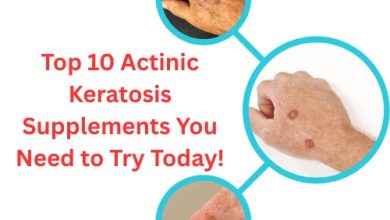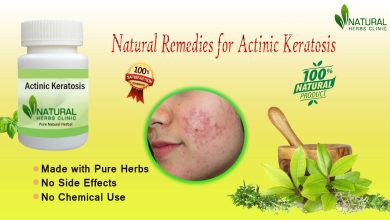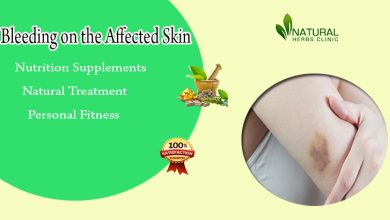Tested Natural Remedies For Actinic Keratosis Treatment
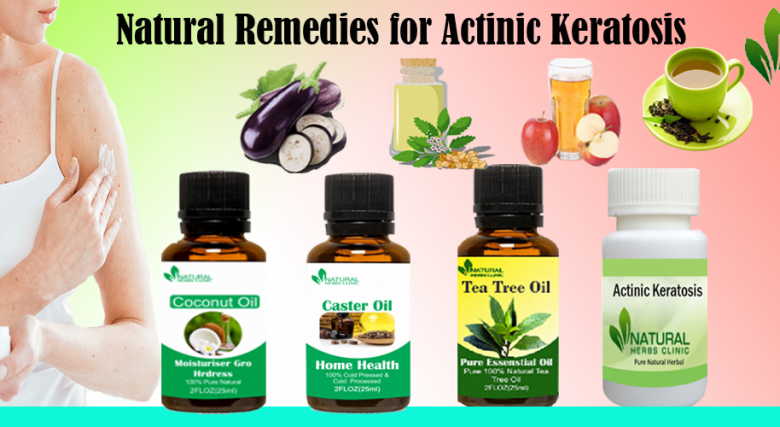
WHAT IS ACTINIC KERATOSIS?
However, there is always too much of a good thing—too much exposure to the sun can be hazardous to our health and wreak havoc on our skin. Actinic keratosis is an example of this and crops up as scaly rough patches that are the result of exposure to the sun. Natural Remedies for Actinic Keratosis is a very effective way to treat the condition completely.
Although it takes years of exposure, it is not something to take lightly. You may first notice these patches on the back of your hands, forearms, neck, ears, lips, ears, or scalp.
These patches may at first appear to be small but may enlarge over time. These patches typically appear on the skin of older adults, so if you’re younger or older and reading this takes note—these patches may develop into skin cancer, however, they are preventable by limiting your sun exposure or taking steps to protect your skin from UV rays.
Related Article; Natural Remedies for Actinic keratosis to Treat the Skin Condition
SYMPTOMS OF ACTINIC KERATOSIS
First of all, if you notice any irregular marks and spots on your body, you should always get them checked out by a doctor right away, as they will be able to determine the difference between cancerous and noncancerous spots.
This is especially true if a mark changes shape or colour, or bleeds. If you suspect you may have actinic keratosis, some symptoms may include:
A scaly or rough patch of skin, on the smaller side, usually smaller than one inch
This patch may be flat or slightly raised; a wart-like bump may appear
Patches that are flesh-coloured, pink, red, or brown in colour
Burning or itching of the affected area
CAUSES OF ACTINIC KERATOSIS
The long and short of it is that actinic keratosis is the result of constantly exposing your skin to UV rays.
This exposure may either be from sunlight itself or from tanning beds. People most at risk for developing actinic keratosis are:
Typically over the age of 40
Live in a sunny/warmer climate
Are known to develop intense sunburns
Constantly exposes skin to the sun
People with pale skin, freckles, light-coloured eyes (blue or lighter), and blonde or red hair
Have previously had actinic keratosis or skin cancer
People with compromised immune systems (typically from organ-transplant medications, chemotherapy, leukaemia, or autoimmune disorders such as AIDS)
Related Article; To Get rid of Try Natural Remedies for Actinic Keratosis
ACTINIC KERATOSIS TREATMENTS
These spots’ scaly rough patches are troublesome; however, if treated early, you can get rid of them before they develop into a more serious problem. First of all, as mentioned above, always get all suspicious spots checked out by a doctor.
Once your doctor has confirmed your actinic keratosis diagnosis, you can take steps to help remove the spots.
Along with whatever treatment your doctor prescribes, there are some Home Remedies for Actinic Keratosis you can try to help get rid of the cosmetic aspect of the spots: the rough, scaly, discoloured patches of skin.
Below are some natural treatments you can try to get rid of actinic keratosis.
Related Article; Home Remedies For Actinic Keratosis: Healing With Natural Treatments
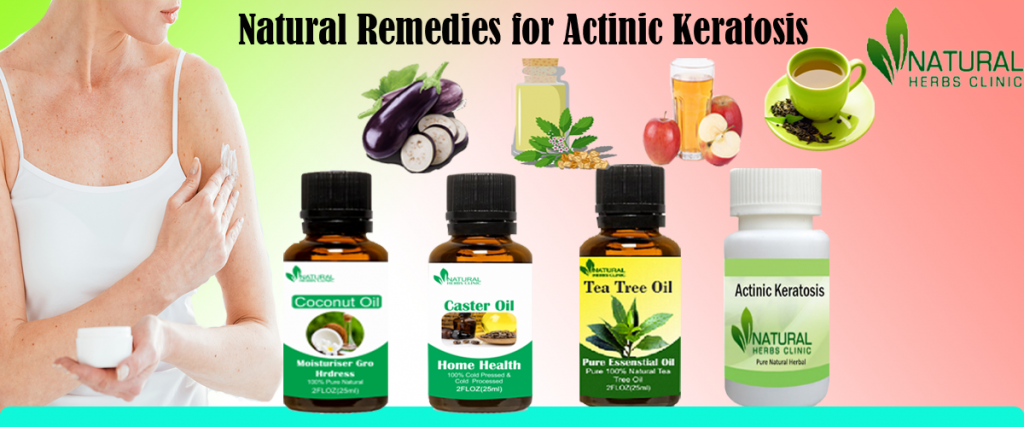
Natural Remedies for Actinic Keratosis
Organic Virgin Coconut Oil
This Natural Treatment for Actinic Keratosis takes diligence, but over time, you should notice results. Regularly applying organic virgin coconut oil to your actinic keratosis spots will eventually remove spots from your face, forehead, nose, scalp, and neck.
Initially, spots may turn red and burn a little, however, within a month; you should notice a softening of the skin as the spots start to vanish.
Apply this Herbal Treatment for Actinic Keratosis directly to the affected area once a day, every day until you notice the spot is gone.
Related Article; Actinic Keratosis Self Treatment: Safe and Natural Solutions for Clearer Skin
APPLE CIDER VINEGAR
Apple cider vinegar, the magic cure-all. This all-star vinegar cures many ailments, especially of this skin. There is currently no published research to confirm its effects on Actinic Keratosis but it is among the most popular Herbal Remedies for Actinic Keratosis used by people suffering from the condition.
Many swear by its effects but others have admittedly found it ineffective. By dabbing a small amount of apple cider vinegar directly onto the affected area, you should hopefully be able to resolve your actinic keratosis within time.
Simply soak a cotton ball in apple cider vinegar and place directly onto the affected spot and then cover with an airtight, waterproof bandage. Wear this bandage overnight and remove it when you wake up.
During treatment, the bump or area may appear white at first, but over time, the acidic content of the apple cider vinegar will help to remove the bump within three weeks.
Related Article; Bleeding on the Affected Skin: Quick Tips for Quick Relief
GREEN TEA
This herbal remedy is great for your health all around, whether you drink it or apply it topically. The astringent properties of green tea make it a great treatment for a host of skin disorders, particularly, actinic keratosis and even skin cancer as the result of constant exposure to UV rays.
After experiencing sunburn, place a green tea bag (that has been soaked in warm water) directly to the affected area of the skin to prevent further damage.
You may also consume green tea or take it in the form of a capsule, which can be purchased from any health food store.
Consuming green tea is generally safe, but be sure not to drink more than 5 cups a day, which may cause headaches, diarrhoea, and irritability in some people.
If applying a teabag to your sunburn causes further irritation of the skin, consult your doctor.
Related Article; Battling Scaly Patches All Over the Skin: Expert’s Prevention Advice
MILK THISTLE
Studies have found that milk thistle may help protect your skin from cancer resulting from UV ray exposure. Although the jury is still out on whether or not this herbal remedy protects your skin from the development of actinic keratosis, it does help protect you from dangerous free radicals that may cause damage to your skin.
Milk thistle can be taken in the form of powder, liquid extract, or capsules.
To determine the proper dosage, consult with your doctor. Some people may experience sensitivity or stomach upset as a result of this treatment.
TEA TREE ESSENTIAL OIL
Tea tree essential oil has a number of amazing benefits including anti-inflammatory and antimicrobial actions that can help treat a range of skin conditions. Many people have had a great deal of success when using tea tree essential oil on their actinic keratosis. Tea tree oil is a very powerful antimicrobial and should not be taken internally not applied to the skin ‘neat’.
Make sure that you dilute it with virgin coconut oil or suitable skin-friendly carrier oil. Apply it to the affected areas several times each day and you will hopefully see some real progress before too long.
Related Article; Itchiness Around the Growths: Policy to Get Relief from Itchiness
FRANKINCENSE ESSENTIAL OIL
Frankincense essential oil is another essential oil with a wide range of skin applications. Studies have looked into the effects of frankincense essential oil on Basal-cell carcinoma – the most common type of skin cancer and one that is rising in incidence.
A case report published in 2013 looked at the effects of frankincense Natural Essential Oil applied topically for a period of 20 weeks. The topical application of the oil led to a significant reduction in Basal-cell carcinoma on the chest and total resolution of the carcinoma on the arm.
According to the researchers, the case study demonstrates that frankincense essential oil might offer an alternative to invasive surgical procedures for skin cancer as well as pre-cancerous conditions like actinic keratosis. However, the researchers recommended that further studies were done with a larger number of patients to confirm the findings. (1)
CASTOR OIL
Castor oil can be used as one of the potential Natural Remedies for Actinic Keratosis treatment naturally. Not everybody has experienced success with it but it has no adverse side effects and is worth trying.
Castor oil may be able to help soothe burning and inflammation of the lesions and help reduce the spots if you apply it regularly over a period of time.
Related Article; Actinic Keratosis Nose Treatment An Overview of the Latest Strategies
EGGPLANT
There is a new treatment that is used for skin malignancies known as BEC5 which is made from phytonutrients that have been extracted from the eggplant.
Early trials have demonstrated that eggplant extract has the potential to treat squamous cell cancers.
Many people have found success when combining eggplant with apple cider vinegar to treat actinic keratosis. You can make your own Herbal Products for Actinic Keratosis with the use of Peggplant cream at home by following a few simple steps.
Take a reasonably sized eggplant and mince it well.
Put it in a jar then add apple cider vinegar until it covers the eggplant.
Place the mixture in your refrigerator and leave it for around 3 days until the vinegar has darkened meaning it is ready for use.
Dip a cotton ball or swab into the mix and apply it to the affected areas several times each day.
ACTINIC KERATOSIS AND DIET
Maintaining a healthy diet is key, to not only keep your body in working order but to prevent such conditions as actinic keratosis and skin cancer as well. Make sure to get at least 5 servings of fruits and veggies every day, especially citrus fruits and broccoli, which are rich in vitamin C, selenium, and antioxidants like beta-carotene.
This will ensure the health of your cells and skin. To boost your immune system, get your daily dose of sea vegetables, whole grains, and beans.
Foods that are known to have immune-boosting, anti-cancer properties are garlic, cabbage, tomatoes, onion, olive oil, grapes, white fish, cabbage, hot peppers, and green tea.
Finally, foods rich in omega-3s and fatty acids are beneficial to the health of your skin, especially when it comes to preventing melanoma. Consuming olive oil, fish oil, butter, and fish cooked in olive oil twice a week will help give you an added layer of protection.
Avoid red meat, processed foods, preservatives, and artificial sweeteners, which are known, cancer-causing agents.
Related Article; Why Treneton is the Best Natural Solution for Actinic Keratosis
DRINK PLENTY OF WATER
Drinking at least 8 glasses of water a day will not only keep you hydrated and feeling great, but it will also help flush out harmful toxins. Regularly staying hydrated keeps your body running in tip-top shape and prevents harmful free radicals from doing damage to your body.
HOW TO PREVENT ACTINIC KERATOSIS
Prevention is key with most disorders of the skin, especially when it involves preventing the development of actinic keratosis and eventually, skin cancer.
When going out into the sun, always take safety precautions as sufficiently covering up your skin or wearing sunscreen.
Limiting your exposure to the sun and avoiding tanning beds are also effective ways of cutting down your chances of developing actinic keratosis.
You should take the following precaution to protect your skin from sun damage :
Limit the time you spend in the sun: This sounds like common sense but it is extremely important if you want to protect your skin from dangerous conditions. You should aim to limit your time in the sun especially when the sun is at its height between 11 a.m. and 2.00 p.m. While many people crave a tan, you should be sensible and not stay in the sun so long that you end up with a sunburn or suntan. Tanning and burning the skin can both cause skin damage bad enough that you risk developing keratoses increasing your risk of skin cancer. Even sun exposure over time can result in actinic keratoses so be careful especially if you live in a country or area with a lot of suns.
Apply Strong sunscreen: Using sunscreen whenever you go outside can greatly reduce your risk of developing solar keratoses. Make sure that you use a broad-spectrum sunscreen with an SPF (sun protection factor) of 15 or more. The American Academy of Dermatology actually recommends a water-resistant sunscreen with an SPF of 30. Apply your sunscreen to all exposed areas of your skin and also apply lip balm to your lips. Reapply the sunscreen every few hours and even more often if you have been swimming or sweat a lot.
Related Article; Take Advantages of Actinic keratosis Home Remedies to Treat Skin Bumps
Cover up well: To make sure that you get even greater protection from sun damage, you should try covering up your body with clothing making sure your limbs are well covered. Wear a hat with a broad brim to protect your face, neck, and shoulders more effectively than a baseball cap or a golf visor.
Avoid the use of tanning beds: While most people are aware of the dangers of sun exposure, many are ignorant of the damage caused by tanning beds. The UV exposure you get from tanning beds actually causes as much damage to your skin as a natural tan you get from the sun. The radiation from tanning beds is absorbed very quickly meaning that photoaging is actually accelerated increasing your risk of developing serious skin conditions like cancer.
Perform regular skin checks: Examine your body on a regular basis and report any changes you find to your doctor. Look for any skin growths and pay attention to any changes in existing growths, freckles, moles, or birthmarks.
ACTINIC KERATOSIS AND CANCER
Fortunately, in the vast majority of cases, actinic keratoses are benign and do not lead to more serious complications. However, the condition does reveal that a person has suffered sun damage which may develop into cancer in the future, in particular squamous cell carcinoma or SCC.
People who suffer from one actinic keratosis might develop more in the future. The more that actinic keratosis remains untreated greater the risk of the lesions developing into a squamous skin carcinoma. This is also true as the untreated lesions get older. Some experts actually interpret actinic keratosis as an early form of skin cancer.
Squamous cell carcinoma is a common form of skin cancer, second only to Basel-cell carcinoma. if it is left untreated, it can be invasive and life-threatening. A variant form of actinic keratosis called actinic cheilitis is an aggressive condition that affects the lips and has a high risk of becoming cancerous. An SCC resulting from actinic cheilitis can penetrate the outer layers of the lips causing them to bleed and develop sores. If this happens, the sore can become infected and can even spread to the internal organs.
Although only around 10% of actinic keratosis turns into cancer, the vast majority of squamous skin carcinomas do begin their life as actinic keratosis. Unfortunately, there is no method of detecting which cases will eventually become carcinomas. For this reason, it is important to treat actinic keratosis seriously and get it treated as early as possible.
Related Article; 10 Home Cure and Natural Remedies for Actinic Keratosis
WHAT IS THE BEST TREATMENT FOR ACTINIC KERATOSIS?
The treatment for actinic keratosis depends on various factors including the patient’s age and general health and the nature and severity of the condition.
Treatment options include :
Surgical procedures like cryosurgery and laser surgery. In fact, cryotherapy is the most common treatment.
Topical treatments: these include 5-fluorouracil, chemical peels, diclofenac, and imiquimod.
Photodynamic therapy.
Combination therapy.
CAN ACTINIC KERATOSIS GO AWAY?
Actinic keratosis can disappear of its own accord but may well reappear some time later. Around half of all keratosis go away when people avoid exposure to sunlight for several years. However, because of the risk of complications including squamous skin cancer, actinic keratosis should not be left untreated.
CAN ACTINIC KERATOSIS TURN INTO CANCER?
In the majority of cases, the condition remains benign. However, in around 10% of cases, actinic keratosis can develop into squamous-cell carcinoma.
IS ACTINIC KERATOSIS CURABLE?
There are a number of effective medical treatments for actinic keratosis; these include surgical procedures like cryotherapy and powerful topical treatments. There is also a wide range of Natural Herbal Remedies and Herbal Supplements for Actinic Keratosis that can help including essential oils, Coconut Oil, and certain herbal remedies.
Visit Natural Herbs Clinic for further details.

